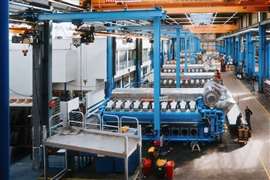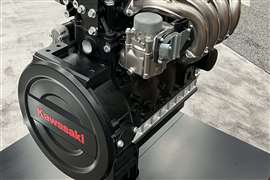Read this article in Français Deutsch Italiano Português Español
Industry experts talk hydrogen IC engines in decarbonization
31 July 2024
At a time when debate continues about the long-term role of internal combustion engines (ICE) in global decarbonization efforts, the non-profit Engine Technology Forum gathered a panel of industry experts in a recent webinar to discuss the future of hydrogen in IC engines as a decarbonization strategy.
“We see the future for ICE as being one of achieving lower emissions, increased efficiency and a switch to sustainable and renewable fuels,” said Allen Schaeffer, executive director at Engine Technology Forum, in introducing the webinar. “And at the end of the day, we also see it very much as a key part of the energy future.”
 Photo: Grispb via Adobe Stock
Photo: Grispb via Adobe Stock
Jim Nebergall, executive director for market strategy at Cummins, said that hydrogen IC engines are within the market’s reach.
“We can be at scale production in the decade because it is conventional technology,” he said. “We know how to make engines — and you’re going to hear it from multiple companies — we know how to make engines run on this fuel.”
Nebergall added that his conversations with end users revealed that many are excited about hydrogen IC engines because “it’s the most diesel-like solution that gets the job done, that provides the power, the torque. It can operate in the existing environments and existing equipment.”
Ivan Tate, head of product engineering, North America, for FPT Industrial, called hydrogen ICEs a “natural step forward” in technology vs. other engines, such as those fueled by natural gas.
Aftertreatment specialist Johnson Matthey also participated in the panel discussion. “Clean hydrogen — we see it playing a critical role in that low-carbon future, particularly in those areas where it’s going to be quite difficult to otherwise decarbonize,” said Louise Arnold, product line director, Light Duty, at Johnson Matthey.
According to Dmitri Konson, vice president of global engineering for powertrain technology company Tenneco, hydrogen-fueled IC engines are key to the future of mobility. “We see it as the most pragmatic near-future step toward towards decarbonization of commercial fleets and off-road machinery.”
Emissions Benefits
One of the key benefits cited by the panelists during the webinar was emissions. Nebergall said that in the case of green hydrogen, which is produced via renewable energy, hydrogen fuel in IC engines is a zero-carbon solution across the entire supply chain.
“If the energy used to create the fuel is renewable, it’s a well-to-wheel story of zero and a tailpipe story of zero [carbon emissions],” he said.
Arnold said one of the benefits of hydrogen fuel is that it can almost be a drop-in replacement for current fossil fuels.
“I say almost — there’s a lot involved in this — but it can be used in a very similar way that we currently do diesel. And therefore, this can be used as an enabler to get us to that even lower carbon future than the one we are anticipating at the moment.”
Nebergall noted that hydrogen fuel has inherently lower nitrogen oxide (NOx) emissions. “Therefore, the aftertreatment technology required to further reduce NOx — it requires less work to knock down the final NOx.”
Regarding aftertreatment, Arnold elaborated upon the approach.
“You have the oxidation catalyst that will deal with any hydrogen slip,” she said. “Then that cleans up the exhaust to go into the reduction step using urea. There could be an ASC (ammonia slip catalyst) there, as well, which would deal with any over injection of the urea potentially.”
Arnold said the final step would be a small particulate filter to address any particulate matter either generated by the engine or a product of the aftertreatment system itself. She added that Johnson Matthey was working with customers on various variations of this approach intended to meet specific needs.
Konson said that the minimal NOx emissions coming from the hydrogen are not a product of the fuel itself, which does not contain nitrogen.
“The only nitrogen that really appears in the exhaust is the nitrogen from the air that is part of the combustion process that is coming into the engine,” he said. “So, the amount of nitrogen is small.”
‘Real Estate’ Concerns
One challenge concerning hydrogen is ensuring enough fuel can be stored aboard a vehicle or machine to make for useful operation. Nebergall said Cummins is looking at having about 80 kg of hydrogen aboard a vehicle, which gives it an equivalent range of about 500 miles.
“That 80 kg — we feel like we can package in typical back-of-cab style,” he said. “It would look very similar to a natural gas truck. You wouldn’t even be able to tell the difference from looking at the tanks, though they are thicker walls because of higher pressure, and they will weigh more.”
According to Nebergall, the total amount of weight added to a truck between the fuel and the tanks is in the area of 2,500 lbs. He added the hope that U.S. Dept. of Transportation (DOT) allowances for alternate technologies, such as those for natural gas, would apply to hydrogen, as well.
Tate added that while it’s relatively easy to find space on an on-highway truck for hydrogen fuel, there are more challenges with off-highway equipment.
“If we look at our big off-road consumers — they’ll drink 1000 L of fuel in one go, one operation, one day,” he said. “We still have packaging concerns. And certainly the cylindrical vessels are more difficult to package, as well.”
POWER SOURCING GUIDE
The trusted reference and buyer’s guide for 83 years
The original “desktop search engine,” guiding nearly 10,000 users in more than 90 countries it is the primary reference for specifications and details on all the components that go into engine systems.
Visit Now
STAY CONNECTED




Receive the information you need when you need it through our world-leading magazines, newsletters and daily briefings.
CONNECT WITH THE TEAM















